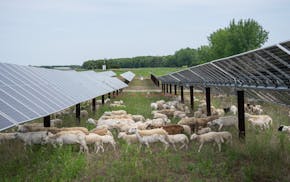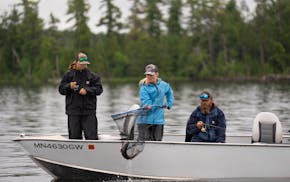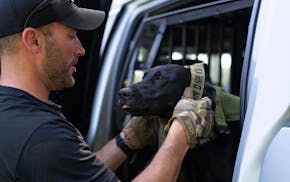A grand plan to reintroduce wild elk to northeastern Minnesota will be delayed at least another year after organizers hit a pair of stumbling blocks, state and tribal officials confirmed this week.
Mackenzie Henk, elk biologist for the Fond du Lac Band of Lake Superior Chippewa, west of Duluth, said Thursday in an interview that leaders of the joint restoration project have decided to delay the first delivery of wild elk to a forested area near Cloquet. She said a recent survey of elk in northwestern Minnesota showed a stagnant population with no surplus to draw upon for relocation purposes.
A second hurdle for the project popped up last week when Red Lake Nation publicly announced its opposition to the movement of any elk from land in the northwest where the tribe has hunting rights. A heavy harvest of elk this year by tribal hunters could put further pressure on elk numbers.
Dave Trauba, wildlife section manager for the Department of Natural Resources (DNR), said gaining Red Lake's cooperation is important.
"It will be a little bit of a challenge but we'll work through that and we'll work through it in a cooperative fashion," Trauba said.
As recently as last week, the first delivery of elk from the northwest to the northeast had been set for early 2026. The reset will delay it until early 2027, Henk said
"We expected to see more population growth," she said. "It definitely put a delay in the project."
DNR elk coordinator Kelsie LaSharr said the results from January's aerial survey revealed surprising stagnation in the three distinct herds that roam prairies, fields and woods in the extreme northwest corner of the state. Removing 12 to 20 of those animals for relocation next year would go against a vow by the state not to detract from Minnesota's existing, localized herds, she said.
"We are committed to the health and the herd size in the northwest and we won't sacrifice that for the restoration," LaSharr said.
Before the early 1900s, elk inhabited most of Minnesota. Their territory shriveled due to settlement, overharvest and the displacement of prairies by agriculture. The DNR's latest total count of remaining elk is 233, including animals that roam back and forth into Manitoba. The survey showed no growth from the previous count in 2023.
In 2014, the Fond du Lac Band first proposed moving elk to northeastern Minnesota as a way to return them to native habitat. Feasibility studies were undertaken and the state Legislature embraced the project two years ago with an appropriation of $2.3 million.
A formal management plan is in the works, but the concept is to move 12 to 20 cows and bulls a year from the northwest to the northeast until the northeast herd is self-sustaining with 100 to 150 animals. The DNR and Fond du Lac Band are managing the project together and have been gathering public comments to help the team write a final plan.
As part of that effort, Henk and LaSharr were in Cloquet on Feb. 13 for a public meeting. Al Pemberton, director of the Red Lake Department of Natural Resources, announced the tribe's opposition to the project, saying his agency was unfairly left out of the project's development.
In an interview, Pemberton said Red Lake Nation is considering a plan to independently harvest as many as 20 or 25 elk this fall from 1863 Treaty lands outside the reservation. That's more than they've ever taken in a single season. Red Lakers started hunting elk in 2023.
"It's in our treaty area. It's not their treaty area," Pemberton said. "We oppose what they're doing. We're totally against it."
He said it will be up to a Red Lake committee to set this year's harvest limit, but tribal members are in no mood to heed elk population goals needed for the translocation of elk to land around the Fond du Lac reservation.
"If we had something in mind to go after the animals in their territory … we'd go talk to them," Pemberton said. "But they didn't do that."
He said Red Lake's message to the Fond du Lac tribe is this: "For every elk you take from here, we'll take a moose from your hunting territory."
Henk, the Fond du Lac elk biologist, referred questions about Red Lake's opposition to tribal spokesman Caleb Dunlap. "The Fond du Lac Band has no comments to provide regarding the Red Lake Nation," Dunlap said.
Trauba, of the DNR, said Red Lake is a stakeholder when it comes to elk management in Minnesota. State-licensed hunters also shoot elk, but the number of tags allowed by the DNR is minimal and fluctuates as wildlife managers try to strike a balance to keep the overall elk population healthy and growing.
"We are concerned with the harvest levels that Red Lake might propose," Trauba said. "The Red Lake tribal harvest does factor into all this."
LaSharr said a new DNR research project will study movements of bull elk starting now. Reproduction is one area of the study because biologists are perplexed with stagnation in the population. From 2016 to 2020, the elk population in Minnesota was showing good growth.
LaSharr, Trauba and Henk said public feedback for the northeast elk restoration plan includes lots of excitement, as well as ongoing concerns about potential harm to agricultural and other conflicts, such as road crossings.
The initial public comment period ends Feb. 28, but project leaders will accept more feedback later this year when a full management plan is drafted for public review.

Xcel lets loose a small army of hungry sheep to keep its solar farm in order

Anderson: In early June, Minnesota fish are begging to be caught. Won't you help?

So you want to get an e-bike? Here's what you should know in Minnesota
Baby opossums are emerging from their mothers' pouches

